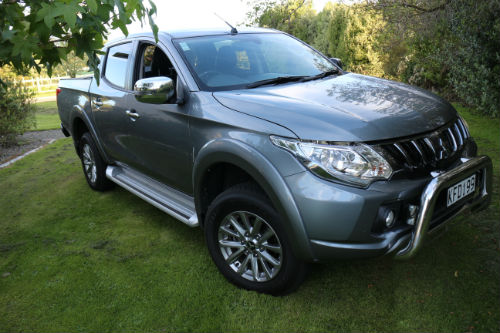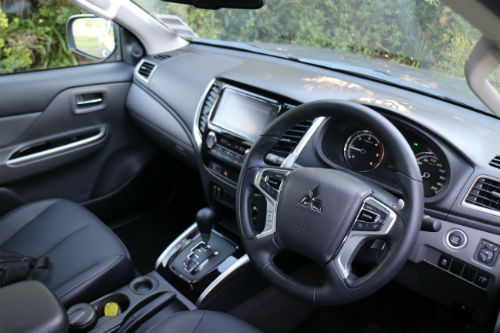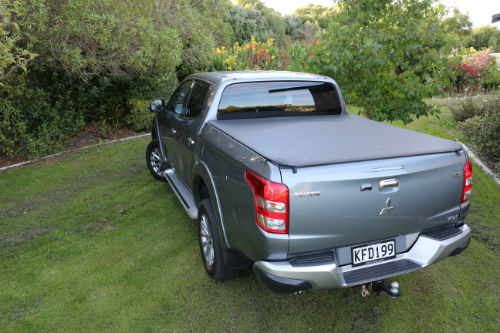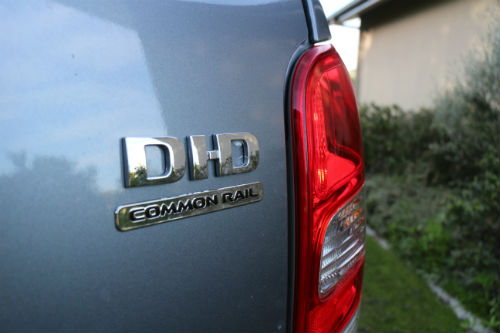Tuesday April 4, 2017
For: Very sharp price, strong specification, looks okay and gets the job done.
Against: Technically-speaking, it’s pretty much second-tier.
By Richard Bosselman
REMOVING the four-wheel-drive component from a high-end one-tonne utility might seem the ultimate emasculation, but in reality these gelded workhorses are what people want.
Wholly two-wheel-drive versions of vehicles that originally set out to make their marque in four-paw format truly are niche performers in sales count terms, but the altered state recipe has built up enough of a following for market dominant Ford and Toyota to each develop rigs that look as if they could but really can’t.
In a way, it’s a bit ironic that the Ford Ranger Hi-Rider and Toyota’s Hilux PreRunner even exist, given that neither of those utes have full-time AWD to start with. Until slipped into 4H, they’re already 2H rides.
Notwithstanding that its Super Select four-wheel-drive system is especially well-named, same goes for the ‘4wd’ Triton. So it also didn’t really require surgery to remove that second shifter.
Then again, getting the snip is clearly a win for the customer. While the removal of that drivetrain reduces kilos, the biggest weight saving by far is wallet-related. At time of writing the 2wd VRX was subject to a special campaign that had it at $39,990 plus on-roads in diesel double cab automatic format. That’s a huge $24k less than the full retail for the four-wheel-drive equivalent!
Design
Not all utes look like utes. The Triton and Mazda’s BT-50 are the two whose styling still seems to split opinion. However whereas Hiroshima’s version of the Ranger seems destined to never gain full acceptance, the Mitsi now seems less confrontational than it did when first. Agreed, the big chrome nose, that capsule-shaped cabin and the impression that it’s a touch too narrow for its height are still part and parcel of its persona, but overall it just doesn’t seem to jar sensitivities. At least, not as much.
The cabin configuration at this level is also quite welcoming; there’s no denying the workhorse background, of course, but the provision of dual-zone climate control, some tasteful fabric highlights – including inserts on the doors – plus some piano black elements with silver accents lessen the visual impact of the hardy grey on dark grey plastics. A leather trimmed steering wheel and gearknob are also provided.
Mitsubishi’s 6.1-inch touchscreen media system is attractive to use, and while Bluetooth phone and audio streaming is standard and useful, the big plus is the enhancement to Apple CarPlay; it’s a simple and effective pathway to all your on-phone infortainment but also Siri telephone voice control and Google mapping on your phone. The screen also affords a reverse-view camera with very good resolution.
Seating is fair. The front chairs are comfortable and the rear bench is quite well shaped, for a ute, but the cabin’s limited width makes this the cosiest offer in the category for a full complement of adults. The pod shape also asks taller types having to duck their head when getting in.
VRX has leather – the shiny kind – and two-staged heating for the front chairs.
Measuring 1520 millimetres long, 1470mm wide and 475mm deep, the tray is usefully-sized and sorted for the sort of lighter-duty jobs that a rear-drive ute would conceivably be restricted to. The deck is not quite big enough to take a pallet – the 1050mm gap between the wheelarches is a touch too tight – and height-disadvantaged types will bemoan, of course, about how high it is.
Our test vehicle arrived with a number of dealer fitted options, including a nudge bar, deck liner, tonneau cover, tow bar package, and carpet mats, which cumulatively added almost $3300 to the list price.
I’d take the deck-related extras – even though cover is one of the old-school stretch-to-fit nailbreaker vinyl types that tend to thrum in a slipstream and have pull tabs that just aren’t quite big enough - wangle the carpets for nothing, forget about the rest. (I mean, a nudge bar on a rear-drive ute? Puh-leeese!). If you want to add extra bling, it’d be better to upsize from the standard, and too small-looking, 17 inch wheels and tyres to 18s or 19s.
Triton’s safety situation is solid, with seven airbags and ESC standard, as well as a five-star ANCAP crash test rating. But the Triton doesn’t go near all the latest fad treatments of lane keeping assist, forward collision warning alert, or active cruise control.
Driving
Save for the obvious omission of the 2H, 4H and 4L selector, a Triton without four-wheel-drive is, in its on-road demeanour, much the same as one with it.
Assuming those roads are sealed. It obviously feels somewhat more tail-happy on gravel – with an unloaded deck, at least – and you have to take more care when driving into the green bits, because there’s no Plan B for extrication.
Our test unit was fitted with a tow bar, which we made good use of without issue. Start-offs were conducted on seal, so there was always good grip, however it did haul a heavily-laden tandem trailer through a dry paddock without showing any sign of losing traction.
Of course, the trick with this truck is knowing when to stop play. Muddy surfaces, soft sand, deep gravel, snow … yeah, you’d want to be rather more circumspect about tackling those. At least clearance won’t be too much of an issue because, in stance, it is identical to the four-by-four.
All Tritons take a 2.4-litre all-alloy direct-injection diesel four-cylinder engine that puts out 135kw of power and 437 Nm of torque. It’s not the most powerful nor the most refined unit in the sector, but still gets the job done, pulling strongly in higher gears but showing willingness at low revs, too. There’s some low rev lag, but with peak torque being delivered at 2500rpm, it soon shows some muscle. What saves the Triton is that it is lighter than most rival utes, so power to weight is not so seriously exposed.
The five-speed automatic okay for this application. Again, that gear count is by no means class-leading – we look forward to the day when the ute steps up to the eight-speed that resides in the Triton-derived Pajero Sport SUV. Much slicker and smoother, it is more attuned to driver desires and driving conditions.
Nonetheless, the current box is okay to live with, especially when driving around town and on the open road – which, let’s face it, is where this version is probably going to be found. At a steady 100kmh, it tickles the tachometer at just under 2000rpm.
Fuel economy with rear-drive only does improve, but not by much: Mitsubishi claims 7.5 litres per 100km, which is just 0.1L/100km better than the 4wd VRX auto achieves. It does feel a little more spirited off the line, but don’t go challenging sports cars.
The car-like features are all well and good, but driving-wise it’s all ute, with a jaunty ride quality, lots of engine roar at times and a sense that, when stopping and cornering, it needs more care and consideration than you’d give a car.
For all that, it’s not as agricultural as you might think. The ride quality might not be quite up to SUV standard, but anyone comparing this generation of Triton with the last should surely notice just how much more settled this one is. Admittedly, yes, the Pajero Sport is more cosseting still; but it has a different rear suspension and is carrying more weight over the back axle.
The steering has reasonable weight but, with 3.8 turns lock to lock, will keep you busy when undertaking tight manoeuvres.
Verdict
We live in a rural area and, though there’s not a ute in the garage, there are times we wish we had one. However, would it be this unit? Given that the cars we do operate are both four-wheel-drive, I guess our preferences are clear.
Even so, you cannot help but think that, even at full retail let alone with a special deal, this is quite a lot of truck for the money.
For sure, you’re not buying latest technology – save in terms of the infotainment – and the price you pay now is going to be the starting figure for its value when it comes time to trade in.
On the other hand, utes generally carry better residual value than any other vehicle type and, though Triton isn’t the most sought-after model, it does have a reputation for reliability and toughness. Plus Mitsubishi wins a lot of business simply by offering the safety net of a very comprehensive warranty, plus five years’ roadside assistance.
This particular variant will seem too soft for some, but it’s well-sorted and highly-specced and, if that’s all you want, it has to make better sense than those other like-configured and much pricier alternates.


